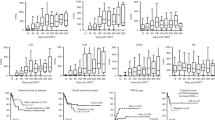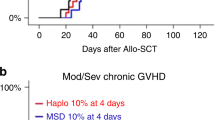Summary:
Successful stem cell transplantation for patients with severe combined immunodeficiency (SCID) from matched family donors without conditioning results in engraftment of T lymphocytes. B lymphocytes engraft in only 50% of the cases, while myelopoiesis and erythropoiesis remain of host origin. Full hematopoietic engraftment was reported in one case after bone marrow transplantation without conditioning for a SCID patient. We studied three SCID patients who were transplanted with unmodified mobilized peripheral blood from HLA-identical family sex-mismatched members. They received megadoses of stem cells (18–23 × 106CD34/kg). In contrast to the expected mixed chimerism that usually occurs in the absence of conditioning, we found in our patients 100% donor cell engraftment based on fluorescence in situ hybridization (FISH) and microsatellite techniques. Subset analysis of the engrafted cells using a multiparametric system enabling a combined analysis of morphology, immunophenotyping and FISH showed that both T and B lymphocytes and myeloid cells were of donor origin in two patients, while T lymphocytes and myeloid cells were of donor origin in the third. In the two cases with ABO incompatibility, erythroid engraftment was evidenced by blood group conversion from recipient to donor type. Multilineage donor engraftment is possible in SCID patients even without conditioning.
This is a preview of subscription content, access via your institution
Access options
Subscribe to this journal
Receive 12 print issues and online access
$259.00 per year
only $21.58 per issue
Buy this article
- Purchase on Springer Link
- Instant access to full article PDF
Prices may be subject to local taxes which are calculated during checkout



Similar content being viewed by others
References
Haddad E, Le Diest F, Aucouturier P et al. Long-term chimerism and B-cell function after bone marrow transplantation in patients with severe combined immunodeficiency with B cells: a single-center study of 22 patients. Blood 1999; 94: 2923–2930.
Buckley RH, Schiff SE, Schiff RI et al. Hematopoietic stem-cell transplantation for the treatment of severe combined immunodeficiency. N Engl J Med 1999; 340: 508–516.
Rubocki RJ, Parsa JR, Hershfield MS et al. Full hematopoietic engraftment after allogeneic bone marrow transplantation without cytoreduction in a child with severe combined immunodeficiency. Blood 2001; 97: 809–811.
Smith A, Robson LG, Sharma P et al. Application of interphase FISH on direct bone marrow smears for evidence of chimerism in pediatric sex mismatched bone marrow transplantation. Pathology 1999; 31: 25–28.
Dubovsky J, Daxberger H, Fritsch G et al. Kinetics of chimerism during the early post-transplant period in pediatric patients with malignant and non-malignant hematologic disorders: implications for timely detection of engraftment, graft failure and rejection. Leukemia 1999; 13: 2060–2069.
Shimoni A, Nagler A, Kaplinsky C et al. Chimerism testing and detection of minimal residual disease after allogeneic hematopoietic transplantation using the bioview (Duet™) combined morphological and cytogenetic analysis. Leukemia 2002; 16: 1413–1418.
Trakhtenbrot L, Reichrat M, Shimoni A . Chimerism testing and detection of minimal residual disease after allogeneic hematopoietic transplantation using the Duet™ (BioView) combined morphological and cytogenetics analysis. Leukemia 2002; 16: 1419–1422.
Tjonnfjord GE, Steen R, Veiby OP et al. Evidence for engraftment of donor-type multipotent CD34+ cells in a patient with selective T-lymphocyte reconstitution after bone marrow transplantation for B-SCID. Blood 1994; 84: 3584–3589.
Rachamim N, Gan J, Segal H et al. Tolerance induction by ‘megadose’ hematopoietic transplants. Transplantation 1998; 65: 1386–1393.
Bertrand Y, Landis P, Fridrich W et al. Influence of severe combined immunodeficiency phenotype on the outcome of HLA non-identical, T-cell-depleted bone marrow transplantation. J Pediatr 1999; 134: 740–748.
Author information
Authors and Affiliations
Corresponding author
Rights and permissions
About this article
Cite this article
Bielorai, B., Trakhtenbrot, L., Amariglio, N. et al. Multilineage hematopoietic engraftment after allogeneic peripheral blood stem cell transplantation without conditioning in SCID patients. Bone Marrow Transplant 34, 317–320 (2004). https://doi.org/10.1038/sj.bmt.1704565
Received:
Accepted:
Published:
Issue Date:
DOI: https://doi.org/10.1038/sj.bmt.1704565
Keywords
This article is cited by
-
How and when should we monitor chimerism after allogeneic stem cell transplantation?
Bone Marrow Transplantation (2005)



